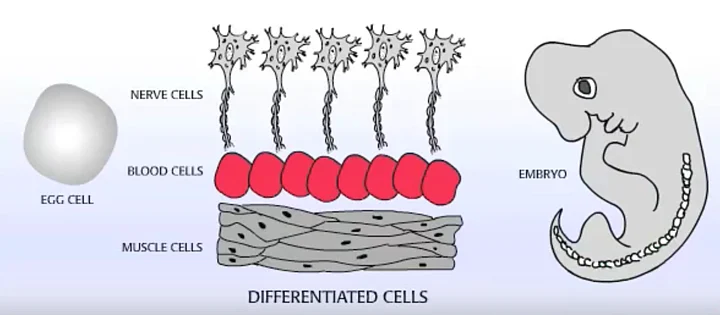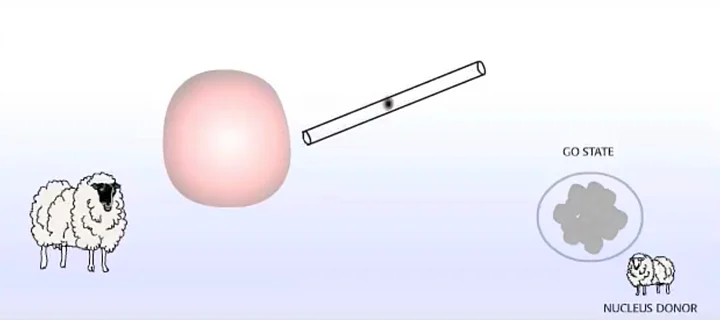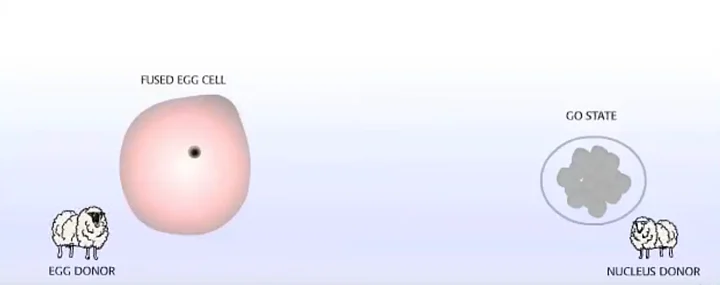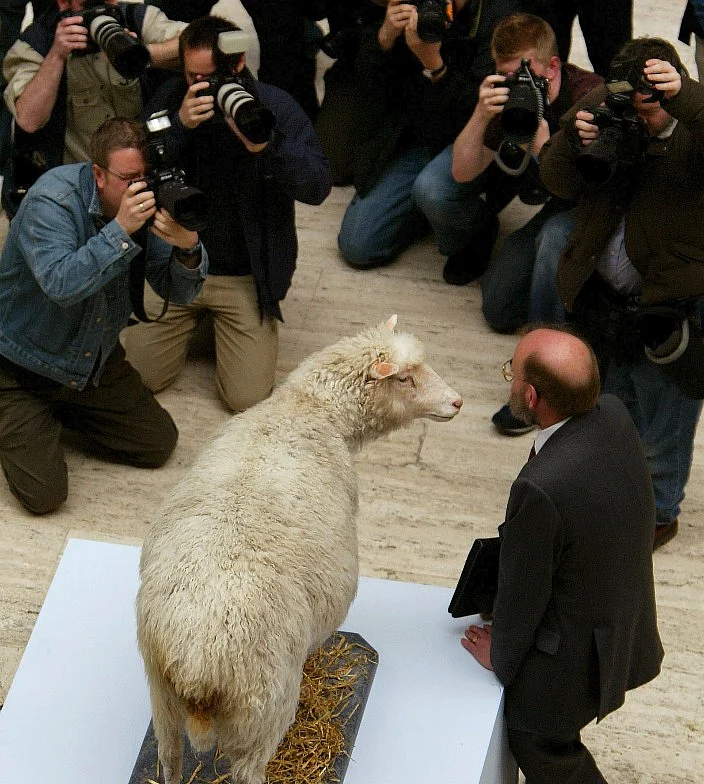On 5 July 1996, an unexpected birth was announced. A fax, delivered to Karen Mycock (now Mrs Karen Walker) a cell biologist with the Roslin Institute, University of Edinburgh, Scotland, read as follows:
[...] she has a white face and furry legs.
Thus, Dolly, a Finn-Dorset (cross-breed) sheep, became the first mammal to have been successfully cloned from an adult cell.
However, it was nearly a year later on 22 February 1997, that the team of scientists at Roslin led by British embryologist Sir Ian Wilmut, announced Dolly’s birth to the world.
Initially codenamed ‘6LL3’, the sheep was named after the famous American country singer of the mid 60’s, Dolly Parton. Dolly’s birth heralded a new beginning in science, one that raised questions about human cloning in the future.
Not the First Cloned Mammal
Contrary to popular belief, Dolly is not the first ever cloned mammal. According to the University of Edinburgh’s Centre for Regenerative Medicine , that distinction lies with another sheep, cloned from an embryo cell and born in Cambridge, UK, in 1984 – over a decade before Dolly’s birth. Moreover, Megan and Morag – two other sheep – had previously been cloned from embryonic cells grown in a lab at Roslin in 1995.
However, what makes Dolly’s creation so significant is that she was the first mammal to be cloned from an ‘adult cell’, something deemed impossible at the time.
Dolly’s birth was announced by the Roslin Institute at the same time as the publication of an article on the same titled “Viable Offspring Derived from Fetal and Adult Mammalian Cells” in scientific journal ‘Nature’.
Born to a Scottish Blackface (the commonest breed of domestic sheep in the UK), Dolly was cloned from an adult cell of a different ewe, using a procedure called somatic-cell nuclear transfer (SCNT). She was the first animal to be cloned using this method.
So what are clones, you ask? Clones are organisms that have identical genetic material, which means that the sequence of bases in their DNA is exactly the same. In fact, identical twins or triplets are clones of one another.
Cloning Made Easy
Before the scientists at the Roslin Institute discovered how to clone an animal from an adult cell, it was thought that cloning an animal could only be done using embryonic cells, ie, cells present in the early stages of an organism’s development. In the 1950s, scientists created frogs out of embryonic frog cells.
After a small number of cell divisions, embryonic cells begin to transform into the varied types of cells an organism needs, including cells that develop into muscles, etc. This process is called ‘differentiation’.

Earlier, scientists believed that once cells differentiated, they could not be used to create an entire organism. For example, it was thought that in a sheep, udder cells could only make more udder cells, but not a whole sheep. The Roslin team resolved this issue by growing sheep udder cells under ‘starvation conditions’. This put the cells in a state similar to that of the embryonic cells.
An egg cell was taken from another sheep. Then, the nucleus (which contains the genetic material) was separated from the egg cell with a super fine needle.

Then, an electric shock was used to fuse one starved udder cell with one nucleus-free egg cell. 277 of these fused cells were created at Roslin. While the egg cell came from a black-faced sheep, the nucleus came from a white-faced sheep.

These fused cells were then inserted into several different sheep. The surrogate mothers also happened to be black-faced. Of the 277 fused cells, only one progressed to form a developed lamb. And thus, Dolly was born.

Sir Ian Wilmut’s team found that Dolly bore the same DNA as the udder cells she was created from – she is a clone of these udder cells.
The Short Life of Dolly
Barring the incidental photo session and media appearance, Dolly lived a fairly ordinary life with the other sheep at the Roslin Institute, until her death in 2003. During her short life of six-and-a-half years, Dolly bore six lambs with a Welsh Mountain ram named David. She gave birth to her first lamb Bonnie in April 1998, after which she had twins – Sally and Rosie the following year, and triplets – Lucy, Darcy and Cotton in 2000.
After her last delivery in September 2000, Dolly caught a viral infection – Jaagsiekte sheep retrovirus (JSRV) – which causes lung cancer in sheep, along with the other sheep at the Institute.
The following year, Dolly developed arthritis, which was successfully treated with anti-inflammatory medication, although the cause of the disorder was never unearthed.

After two years of a fairly uneventful life, Dolly developed a cough in February 2003. A CT scan revealed that she had tumours growing inside her lungs. The scientists at Roslin decided to perform euthanasia on her, rather than making her suffer.
At the age of six (the average life of a sheep is 10-12 years), Dolly was put to sleep on 14 February 2003.
Dolly’s premature death raised doubts in the minds of scientists that cloned animals might be prone to faster ageing.
A new study, which followed the life of four sheep cloned from the same ewe as Dolly, revealed that they had aged normally. However, a report by the BBC quoted Professor Kevin Sinclair of Nottingham University as saying:
Healthy ageing of SCNT clones has never been properly investigated.
Dolly’s body was donated to the National Museum of Scotland in Edinburgh by the Roslin Institute, where she is a popular exhibit. Alongside Dolly is a display on the ethics of creating transgenic animals featuring current research from the Roslin Institute.

Why Do We Clone Animals?
The same report states that the technique used to create Dolly was the harbinger of ways to create new medical remedies and to save endangered species.
It also claims that cloning as a process, is highly ineffective as, even 20 years of research and several experiments had not led to viable clones.
Animal cloning has many uses, which include the following:
- The mass production of animals with useful traits, for instance, cows that produce a lot of milk.
- Creating animals that have been genetically designed to bear human products like insulin or organs required for transplant, often called ‘therapeutic cloning’.
- Creating human embryos to provide stem cells for treatment.
It is worth noting that the Roslin Institute’s original motive was not to clone a mammal. What they were really trying to do was to create a more reliable method of producing genetically modified livestock.
A report by CNN states that according to the Institute, cloning animals for agricultural purposes has for years been at the heart of cloning. Also, since the mid-80s, cloning has inspired an interest in creating new uses for livestock, including production of human proteins in the milk of transgenic cows of sheep for medicinal purposes.
Ethical Concerns of Cloning
Some of the issues that arise when one thinks of the ethical concerns surrounding animal cloning are that of unnaturalness, diversity, fundamental concerns, animal welfare and commodification. According to Edinethics Ltd, an independent consultancy based in Edinburgh, cloning livestock is often deemed “unnatural” – it is not a natural process, and bypasses natural selection.
Second, one of the basic rules of selective breeding is that a high level of genetic diversity must be maintained. The more a gene pool is narrowed down, the greater is the risk of problems related to in-breeding. This raises the question – how much more is this problem true where cloning is concerned, if this be the case with in-breeding?
Then there is a fundamental ethical concern, which involves religious beliefs. For instance, for Christians, we are all creatures of God and one basic feature of the “natural”world around us is diversity. Thus, some consider the bypassing of the natural order, reducing variety and creating something unnatural as blasphemous.
Animal welfare concerns also arise in this debate. Often, cloning leads to many miscarriages, abnormally large offspring, abnormal development of the placenta during pregnancy, etc. According to a report by Edinethics, this also signals the threat posed to the lives of the clone and the mother during any future attempt at human cloning.
(With inputs from The Economist, BBC Science, Edinethics Ltd, The Roslin Institute, CNN, NYT, DNA Learning Center)
(At The Quint, we are answerable only to our audience. Play an active role in shaping our journalism by becoming a member. Because the truth is worth it.)
